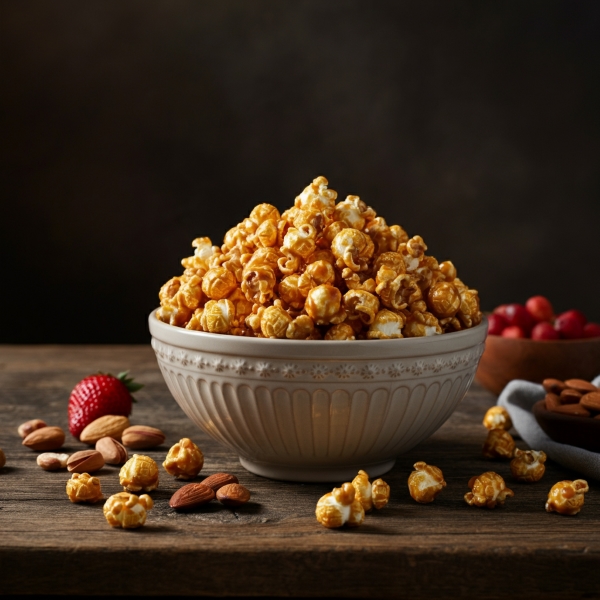
Caramel popcorn is a snack that’s hard to resist sweet, crunchy, and the perfect companion for movies or parties. But as you savor those handfuls, you might find yourself wondering, “Is caramel popcorn healthy or not?”
The answer isn’t as simple as “yes” or “no.” There’s good news if consumed in moderation, but there are certainly health considerations to keep in mind. This blog dives into the nutritional facts, benefits, and potential downsides of caramel popcorn to help you make informed snack choices.
What Is Caramel Popcorn?
Caramel popcorn is a sweet treat made by coating freshly popped corn with caramelized sugar. While traditional popcorn (on its own) is considered a healthy whole-grain snack, the addition of caramel changes its nutritional profile significantly. Let’s explore how.
The Nutritional Breakdown of Caramel Popcorn
Caramel popcorn often contains simple ingredients, such as popcorn, sugar, butter, and sometimes corn syrup or flavor additives. However, these small additions can have a big impact on its calorie count and overall nutritional value.
Nutritional Facts (per average 1-cup serving of caramel popcorn
- Calories: 120–150
- Fat: 5-8g (mostly from butter and oils used in the caramel coating
- Sugar: 15–20g
- Fiber: 1–2g (thanks to the popcorn base
- Protein: <1g
Key takeaway? While caramel popcorn retains some nutrients from its whole-grain base, it is also high in sugar and fat, both of which can raise calorie levels quickly.
The Health Benefits of Caramel Popcorn (Yes, There Are Some!)
While it may not be classified as a “health food,” caramel popcorn isn’t all bad when enjoyed in moderation. Here’s how it stacks up:
1. The Popcorn Base Is a Whole Grain
Did you know that popcorn before being coated in caramel is actually a whole grain? Whole grains are known for providing fiber, which aids in digestion and can help you feel full longer. Although caramel limits the fiber benefits, it’s good to know that not all nutritional value is lost.
2. A Sweet Treat That’s Convenient and Portable
Craving something sweet? Caramel popcorn allows you to satisfy your sweet tooth in controlled portions without going for ultra-processed snacks with artificial flavors or dyes.
3. Versatility Meets Fun
Popcorn is more than just a snack it’s a source of joy, nostalgia, and fun (think movie nights and festive gift tins!). Emotional well-being matters too, and caramel popcorn can be part of life’s simple pleasures.
Why Caramel Popcorn Might Not Be the Healthiest Choice
While it has its merits, caramel popcorn is not without its drawbacks. Here are a few points to consider before you reach for another handful.
1. High in Sugar
The caramel coating significantly increases the sugar content, with one cup containing up to 20g of sugar that’s nearly 5 teaspoons. High sugar intake is linked to conditions like obesity, diabetes, and heart disease. If you’re monitoring your sugar consumption, caramel popcorn might not be the best choice.
2. High in Calories
Those crunch-coated kernels pack a calorie punch, with about 120–150 calories per cup. If you’re snacking mindlessly (yes, we’ve all done it), the calories can add up faster than you think. A single movie-size bag can contain several hundred calories.
3. Low in Essential Nutrients
While popcorn is a whole grain, caramel popcorn lacks substantial vitamins or minerals to offset its caloric density. It’s a high-energy, low-nutrition food when consumed in large amounts.
4. Additives and Preservatives
Pre-packaged caramel popcorn brands often contain artificial flavors, hydrogenated oils, and preservatives to extend shelf life. These extras can add health risks over time, including increased cholesterol levels or exposure to synthetic chemicals.
How to Enjoy Caramel Popcorn Responsibly
You don’t have to give up caramel popcorn completely to stay on track with your health goals. Here’s how to indulge in this crunchy treat without guilt:
1. Portion Control Is Crucial
Stick to smaller portions try measuring 1 cup instead of eating straight from the bag. This helps you keep track of your calorie and sugar intake.
2. Make Your Caramel Popcorn at Home
Skip the additives by making caramel popcorn at home! You can control the ingredients, use less sugar, and swap butter for healthier oils like coconut oil. Try adding a sprinkle of sea salt for a tasty sweet-and-salty combo.
3. Pair It With Healthier Snacks
Balance the sugar content by pairing caramel popcorn with healthier options, such as a handful of nuts or fresh fruit slices. This creates a more balanced snack plate.
4. Save It for Special Occasions
Caramel popcorn is best enjoyed as an occasional treat rather than a daily indulgence. Think of it as a fun snack for celebrations, movie nights, or holiday gatherings.
5. Opt for Healthier Store-Bought Versions
If you’re short on time, some brands offer lower-sugar caramel popcorn or versions made with organic ingredients. Read the labels carefully and choose options with minimal additives.
The Final Verdict
Is caramel popcorn healthy or not? It depends on how you consume it. While caramel popcorn isn’t the healthiest snack in the world due to its high levels of sugar and calories, it can certainly fit into a balanced diet when enjoyed in moderation.
Want to enjoy caramel popcorn guilt-free? Stick to smaller portions, or take the DIY route to create a lighter version at home. Remember, nutrition isn’t just about what you eat it’s also about how much and how often.
Looking for more tips on healthy treats, recipes, or balanced snacking? Stay tuned to our blog for expert tips and ideas!
